Stuffed grape leaves are a delicious Mediterranean mezze. In my meatless version of this recipe, I stuff blanched grape leaves with rice, fresh herbs, and pine nuts. Lemon zest adds a lovely essence. They’re especially nice chilled, served alongside other salads and cold mezze for a light summer meal. If you’ve never tried them before, this is a fun vegan cooking project with healthy, delicious results!
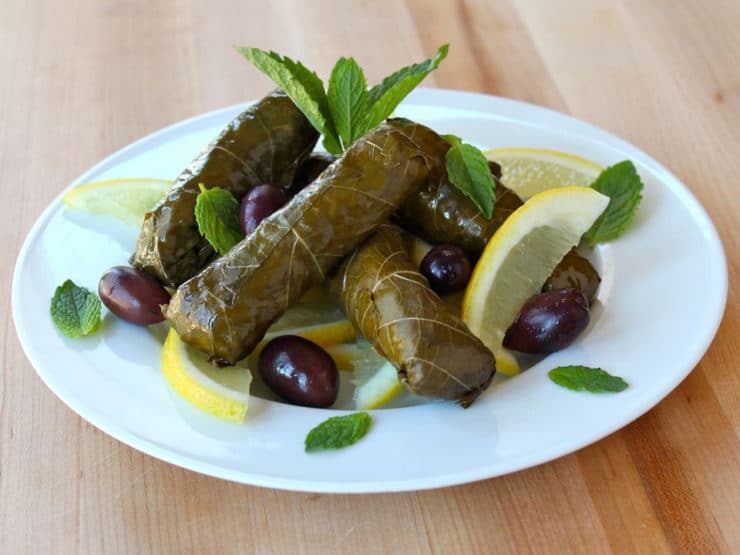
Stuffing grape leaves used to intimidate to me. It seemed like such a complicated, foreign process. I sought advice from a friend of ours named Tony, who owns a Greek restaurant in Malibu. Tony makes the best meat-stuffed grape leaves ever (fingers crossed he’ll share his recipe with me soon!). He told me that stuffing grape leaves is a lot easier than it seems– all you really need is a little time and patience.
I decided to take his advice and try making vegetarian grape leaves first. And you know what? He’s right! There was a learning curve, but once I understood the process, it became second nature. The first time I made them, I used a simple herbed rice as a filling. Over time I tweaked it, adding more herbs, onion, and lemon for flavor and pine nuts for texture/protein.
The result? Delicious! Not to mention vegan, parve, gluten free, healthy– you get the idea.
How to Make Stuffed Grape Leaves
I’ve provided a clearly photographed step-by-step tutorial. Are you lucky enough to have a pesticide-free grape vine in the back yard? Use those leaves! If you don’t (wish I did!), you’ll need to buy 1 or 2 large jars of grape leaves. You can find these at Middle Eastern markets or specialty stores. They can also be found online. I usually end up using a little more than 1 large jar, since many of the leaves end up damaged and unsuited to stuffing. You can use the damaged leaves to line the bottom of the pot, which helps to prevent scorching.
When to Serve Stuffed Grape Leaves
I often make these vegan stuffed grape leaves for the Jewish holiday of Sukkot. On this holiday we are encouraged to create dishes from fresh seasonal ingredients. Sukkot ushers in the autumn season, and menus are inspired by the bounty of the harvest. That means lots of apples, squash, eggplants, figs, grapes, and– you guessed it– grape leaves!
While these are very appropriate for Sukkot, you can obviously serve these stuffed grape leaves year-round. They’re especially nice served chilled during the hot summer months. Garnish them with fresh mint leaves, lemon slices and olives for a lovely presentation.
Other Mezze Recipes:
Recommended Products:
We are a participant in the Amazon Services LLC Associates Program, an affiliate advertising program designed to provide a means for us to earn fees by linking to Amazon.com and affiliated sites. As an Amazon Associate I earn from qualifying purchases.
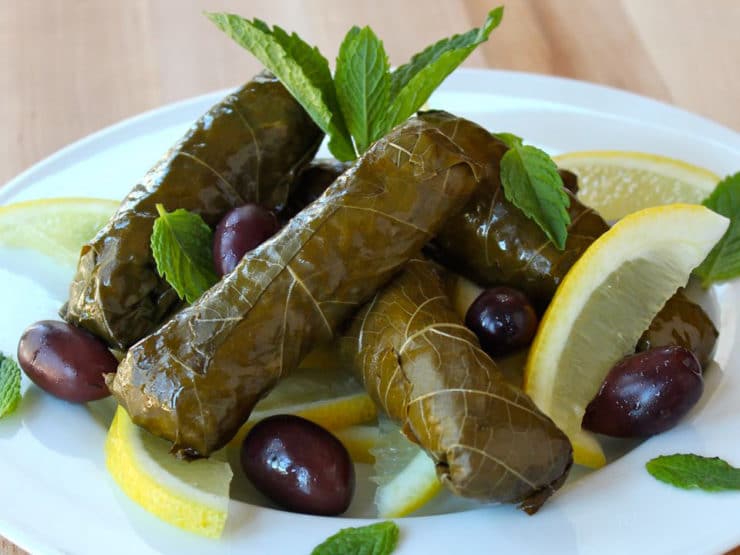
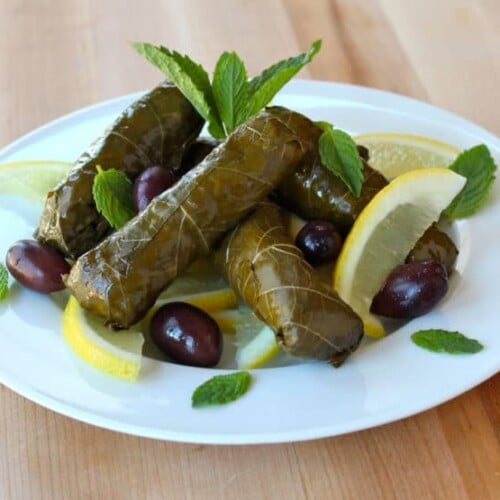
Vegetarian Grape Leaves (Dolmades)
Ingredients
- 1/2 cup pine nuts
- 1 1/2 cups long grain white rice
- 1 medium onion, minced
- 1/2 cup fresh minced dill
- 1/4 cup fresh minced mint
- 6 tablespoons freshly squeezed lemon juice, divided
- 1 tablespoon lemon zest
- 1 3/4 cups vegetable broth (a yellow broth is best), divided
- 50 large grape leaves (fresh or jarred)
- Salt and pepper
- 1/2 cup extra virgin olive oil
- Fresh mint leaves, lemon slices, and olives (for garnish - optional)
NOTES
Instructions
- Pour the pine nuts into a skillet and lightly toast them over medium heat till golden brown. Reserve.Pour ¼ cup of olive oil into a medium pot and heat it over medium. Add minced onion to the pot and sauté until soft. Add the rice to the pot and stir to combine. Sauté for another minute. Pour in ¾ cup vegetable broth and lower the heat; simmer the rice uncovered for about 10 minutes till the liquid is absorbed and the rice is half cooked. Do not cook the rice fully, or you’ll end up with mushy grape leaves! Just cook it to an al dente texture. Remove pot from heat.

- Add the minced dill, mint, toasted pine nuts, 2 tbsp fresh lemon juice and lemon zest to the pot of rice. Stir till all ingredients are well combined. Season with salt and pepper to taste. Let the mixture cool to room temperature.

- Fill a large pot with salted water and bring to a boil. As the water is heating, trim the leaves by cutting the stems off, flush with the leaves. Trim any large, hard veins from the leaves. Place the leaves in the boiling water and let them soften for 3-5 minutes till they become pliable (fresh leaves may take a bit longer to soften than jarred).

- Drain, then cover the leaves with cold water. Drain the leaves again and pat them dry.Note: If using fresh leaves, try to use younger leaves (medium size)—they’ll be more tender than the very large leaves.

- Place a grape leaf shiny (smooth) side down, vein (bumpy) side up, on a flat surface like a cutting board.

- Place 2 tbsp of rice filling at the base end of the leaf, near where the stem was.

- Fold the stem end up over the filling.

- Fold the edges of the leaf inward.

- Continue rolling the leaf till it forms a neat rolled package. Do not roll too tightly; the rice will expand a little during cooking, and if you roll it too tight the leaf will unravel as it cooks.

- Squeeze the roll gently to seal.Repeat the process with the remaining leaves till all of the filling is gone.

- As you roll the leaves, you may find some leaves that are damaged or have large holes. Place those damaged leaves into the bottom of your saute pan to line it and create a bed for the stuffed leaves.

- Place the stuffed leaves in the bottom of the saute pan. Don’t be afraid to pack the leaves snugly; this will help keep the leaves intact as they cook. Make a single layer on the bottom of the pan. When you run out of room, make a second layer on top.

- Pour 1 cup of broth, ¼ cup of extra virgin olive oil, and ¼ cup of fresh lemon juice over the stuffed grape leaves. Heat the pan over medium until it begins to simmer (don’t boil, or the leaves will start to fall apart).Cover the pot. Let the grape leaves cook for 30-40 minutes. The leaves are finished cooking when they are fork-tender.

- Stuffed grape leaves can be served warm or cold, as-is or topped with a variety of sauces. I like serving them with fresh tzatziki or tahini sauce—recipes for both can be found on my blog. Store them in the refrigerator; they will keep for about 1 week.

Nutrition

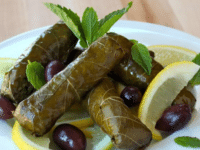
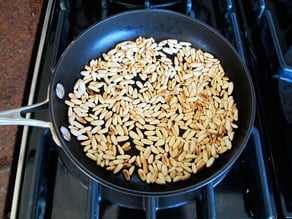
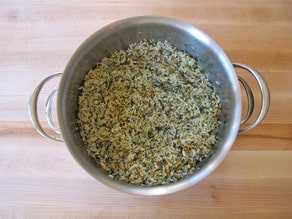
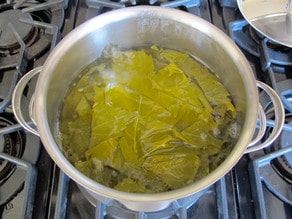
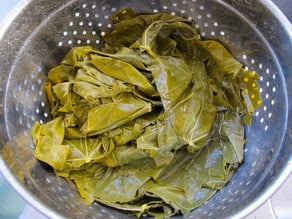
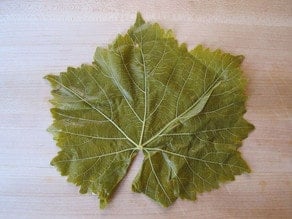
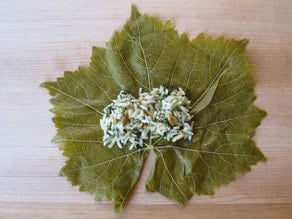
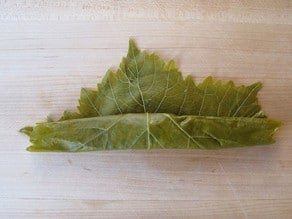
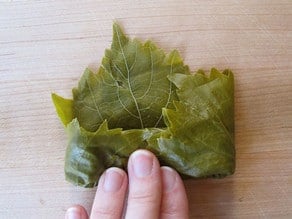
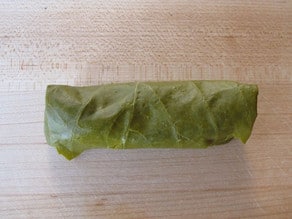
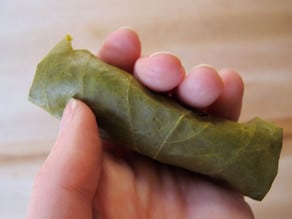
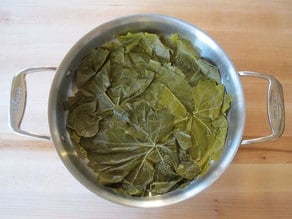
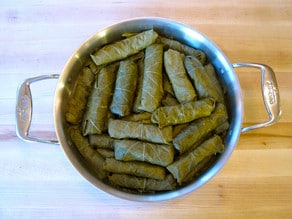
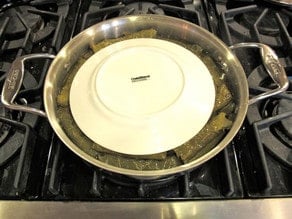
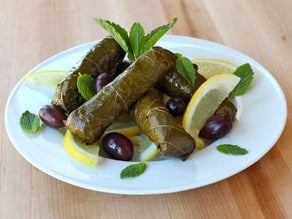


Can these be frozen?
Hi Chas, Tori’s assistant Ashley here. I do not have experience with freezing these, however I’ve done a bit of research and it looks as though they are fine to freeze. After cooking allow them to come to room temperature, then store them in airtight bags or an airtight container in the freezer. When you are ready to eat them, allow them to thaw completely in the refrigerator first, then steam on the stovetop to warm them up again. Hope this helps!
I hate the canned product and my costco no longer carries the ones I loved. I can’t wait to try this .. and I think I’ll use basmati as well. Thank you! !
LiZa
I’m excited to make these. The ones we can no longer get at our Costco left a hole in our hearts. Glad we aren’t the only ones!
Can you substitute basmati rice ?
Hi Lisa, Tori’s assistant Ashley here! Yes, you can certainly use basmati rice if you’d prefer.
Made these as appetizers before Thanksgiving dinner. Some leaves fell apart as I was rolling them up so many were not pretty. Getting them out of the pan, intact, was also a bit tricky. Lining the pan made it difficult to get the rolls out; I won’t do this next time. Delicious though!
These were absolutely delicious- awesome recipe!
Followed the excellent recipe loosely but very successfully. The main modification was to use coarse bulghur instead of rice for protein intake reasons. Mint & dill is a great combination of herbs. Thank you!
So do you cook the bulghur some before stuffing and if so for how long?
I make “the best meat dolmades” according to my ex, but really think this looks like a GREAT veggie alternative. I’ve always used mint and dill and basmati rice. Also fresh lemon.
Made these yesterday with some slight alterations: added about 1/2 cup of lentils to the rice mixture, used a more concentrated veggie broth made from bouillon cubes, and slightly more lemon juice. Best dolmas I’ve ever had. These have way more flavor than any dolmas I’ve had at a restaurant or purchased in a store. It’s a pretty time consuming recipe but definitely worth it!
Fabulous Jamie. Love the addition of lentils to make this a complete protein!
Can I replace the pine nuts with hempseeds also, can I use wild rice as oppose to white rice???
These were amazing! They weren’t quite ready at 20 but 30 minutes was too long and they got a little hard. Will keep checking every couple of minutes when it hits 20 mins. next time. The flavors were incredible. Really enjoyed the mint and dill and lots of lemon. The flavors all blended beautifully. We can’t wait to make again. Thanks!
Wow! I just finished making these tonight, and they are so good. A bit labor intensive, but totally worth it. Thank you for posting this recipe. 🙂
You’re welcome Frankie!
Tori,
Did you ever think a posting dating back to 2011 would still be active in 2015..how cool is that! I am a great fan of Doma and have had the pleasure of making them with my Greek grandmother and my mother as well. Now married with kids, I will be sure to pass the beauto that is sitting around a table, stuffing and folding grape leaves. Though I personally like the meat variation more, I do enjoy the veggie dolma as well. With avgomolo or white sauce.
That is very cool Diego! I love avgolemono sauce too, I should do a post about it. 🙂
These are similar to an Armenian recipe I use. I would not make this, I am not a fan of dill in much other than pickles and dill and mint, while very middle eastern, are just beyond the pale for my tastes.
My version has rice, onions and raisins. I prefer chicken stock but could use veggie stock.
Hi Tory! I’ve made this recipe at least three times! Since pine nuts are hard to get here in Chile where I live, I’ve used sunflower seeds and toasted walnuts on different occasions. I have also served them at a Daniel banquet during a retreat with young people and my arab christian friends were very surprised at how good they were and asked for the recipe. They also helped me to wrap some in cooked cabbage leaves (malfuf) They were really yummy!!! This will be the recipe I pass down to future generationa!!
Really happy you enjoyed it Alicia!
Hi, Tori. I love your site! This recipe sounds delicious! I am going to my daughter’s next week to help cook for Passover, and we’ll be making stuffed grape leaves as part of the menu; my son-in-law’s family is Sephardic, and rice is acceptable. Your recipe and step-by-step directions — AND PHOTOS — seem like it will be easy and fun!
Enjoy MaxS! Sephardic Passover is the best!
These were really good and authentic-tasting! I used maybe 1.5 tsp of salt, and went a little heavy on the fresh lemon juice. I found that the cooking time for the stuffed leaves needed to be closer to 50-60 minutes in order for the rice to absorb the liquid. Due to cost, I will probably substitute the pine nuts with something else in the future, but I will definitely be making this again!
I made these for the first time and they turned out great! It took a few times to get the hang of it. The next time I make them will be on a weekend. They took about 3 hours to make start to finish and I started at 10 pm!
I’m sorry to say, but the Greeks do not know how to make stuffed grape leaves. They make them sweet and slimy. To get good stuffed grape leaves, go to Lebanon! So tangy.
Tori’s technique is authentic. The one step I would take issue with is softening the leaves. Jarred grape leaves are already soft. For jarred leaves, put them in a bath of cold water to loosen the tightly packed leaves from each other and to remove the brine they are packed in. Fresh leaves are best in June, and, after hand washing each leaf, they’ve always been soft enough for rolling.
Tori, I made these last night, substituting chickpeas for the pine nuts and using grape leaves from a wild vine we have in our yard, and my husband and I really liked them. They were delicious, and very easy to make. I pre-cooked the leaves and the rice the day before, so last night all I had to do was mix the rice with the other ingredients, fill the leaves and finish cooking them. As a side dish, I added peeled eggplant cubes and asparagus to the same pan I cooked the leaves in, and when it was all done, I removed the eggplant and asparagus and seasoned them with olive oil and lemon juice. Thank you for this recipe!
Great idea to cook the side dishes along with the grape leaves!
Hey, Tori,
Couple of questions: can I use basmati rice, or is the flavor too strong? Also, what about brown rice if I use more broth and cook longer. If brown rice really doesn’t work, I can do white, just curious. Thanks for any tips. You are my go-to sight for all things Middle Eastern. Any recipe goes through the Tory Avey research first. Love your site!
Hi Anne, basmati will work great. Brown rice would probably work too, but I would cook it closer to done– perhaps 3/4 done rather than 1/2 done– since it will take longer to finish cooking to tender inside the grape leaves (yes, this will take more broth). Mind you I haven’t tried it myself, but as long as the rice gets tender I don’t see why it wouldn’t work. FYI since posting this recipe I’ve tried adding cooked chickpeas to the filling, which gave it a nice boost of “meatiness.” Just in case you’re experimenting. 🙂 So happy you’re enjoying the site! That is quite a compliment.
Hi Madhatter,
Preparing home grow vine leaves is easy. Pick medium size leaves . Place leaves in a tub pour over hat water and let then sit. Give them a bit of a stir until they change colour. I then drain and cut off the stems. You can use them straight away or lay them on top of each other and freeze them in snap lock bags until you need them. When using out of the freezer you need to thaw them or quickly refresh them with hot water.